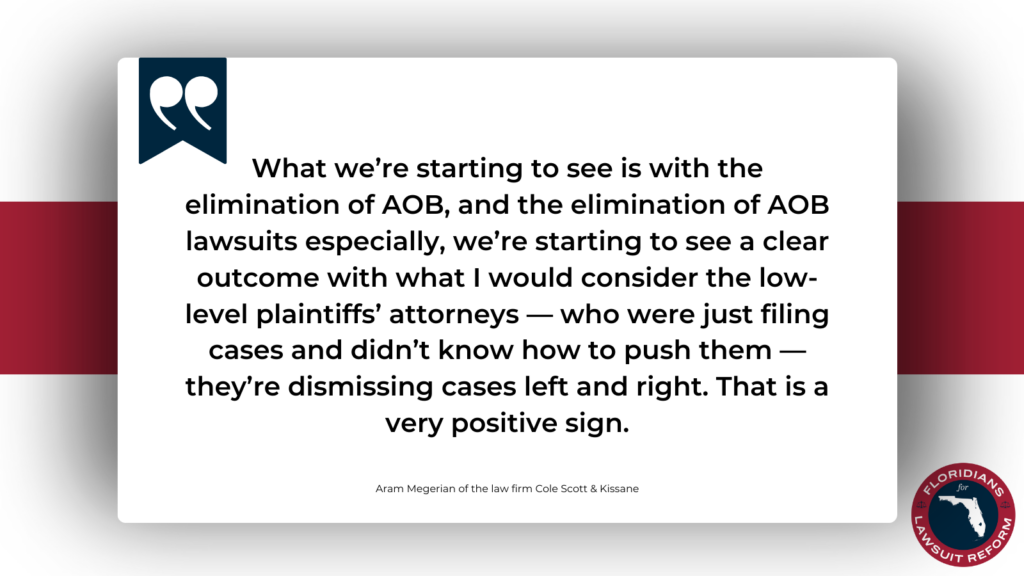
Lawmakers have taken several stabs at stabilizing the state’s insurance market, but many insurers and policyholders haven’t reaped the benefits — yet.
Attorneys Scott Shelton and Aram Megerian of the law firm Cole Scott & Kissane, who represent insurers in civil litigation, told attendees at the 2023 Florida Chamber Insurance Summit that the impacts of the recent tort reform bill and other legislative interventions are starting to trickle through the court system.
There are only a couple of barriers remaining, one of them being the resolution of cases filed before those laws went into effect.
“One of the things that we’re seeing for sure, is there was a COVID backlog, and that still exists in civil litigation,” Megerian said. “The courts are trying to push it as fast and as quickly as they can. That doesn’t mean that it’s going to move as quickly as we’d like, but they’re pushing as hard as they can with a significant backlog.”
While the pandemic added to the backlog, Megerian said there was already a glut of property insurance cases in the courts.
“There are so many old property cases, whether it’s a cast iron pipe case or Hurricane Irma cases, that still exist in the pipeline, for lack of a better term, and you see a lot of circuit court judges getting frustrated with the number of property cases that fall on their courtroom, almost like when people got very frustrated with the mortgage cases back about seven or eight years ago right before COVID,” he said.
Megarian also said AOB reforms are starting to bear fruit as well. AOB, or assignment of benefits, is a legal process that allows policyholders to sign over their insurance benefits to a third party in exchange for a quick repair.
Lawmakers in 2019 passed an AOB reform package that placed significant restrictions on the practice, which insurers argued inflated claims settlements and, as a result, drove up premium costs for consumers statewide.
“What we’re starting to see is with the elimination of AOB, and the elimination of AOB lawsuits especially, we’re starting to see a clear outcome with what I would consider the low-level plaintiffs’ attorneys — who were just filing cases and didn’t know how to push them — they’re dismissing cases left and right. That is a very positive sign,” Megarian said.
He noted that the “velocity” of case filings — how quickly they flow in following a storm — is falling and that rulings have been less onerous for insurers.
“I think, as a rule, we’re seeing much better rulings and much more sound rulings from all the districts,” he said. “We still have not really had the Supreme Court weigh in just yet. But we do anticipate getting some rulings that are much more positive than what we’ve had over the last 30 years.”
Shelton added that tort law changes are starting to shift the perception that Florida is a “judicial hellhole.” The American Tort Reform Association, which bestows the designation, said last week that it no longer applies following the implementation of this year’s torts bill and separate legislation placing restrictions on legal ads placed by personal injury firms that were framed as “medical alerts.”
“Before March 2023, Florida was referred to as a pure comparative fault state, meaning, to boil up everybody in the room, that is I fall and it’s 70% my fault and the case is worth $50 million dollars we get 30% of that, right? And that’s still a tough number for most people and most companies, particularly insurance companies, to digest,” Shelton said. “That is now going to change.”
The new law dictates that if a personal injury plaintiff is more than 50% at fault, they cannot recover damages from the other party.
“Plaintiffs’ attorneys said ‘that’s terrible, that’s mean and that’s not right for the plaintiffs, who should be given a pro rata share.’ Well, if you look at the rest of the country, it’s actually very consistent with what other jurisdictions do.”
